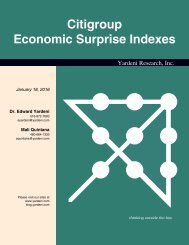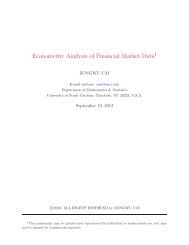Illiquid Asset Investing 1. Liquidating Harvard
Illiquid Asset Investing 1. Liquidating Harvard
Illiquid Asset Investing 1. Liquidating Harvard
You also want an ePaper? Increase the reach of your titles
YUMPU automatically turns print PDFs into web optimized ePapers that Google loves.
Andrew Ang <strong>Illiquid</strong> <strong>Asset</strong> <strong>Investing</strong> <strong>Asset</strong> Management<br />
Poisson arrival events have been used to model search-based frictions since Peter Diamond<br />
(1982). Diamond was awarded the 2010 Nobel Prize. In 2011, he was nominated to serve on the<br />
Federal Reserve Board of Governors, but Republican opposition prevented his confirmation.<br />
<strong>Illiquid</strong>ity risk causes the investor to behave in a more risk-averse fashion toward both liquid and<br />
illiquid assets. <strong>Illiquid</strong>ity risk induces time-varying, endogenous risk aversion. <strong>Harvard</strong><br />
discovered in 2008 that although it is wealthy, it cannot “eat” illiquid assets. <strong>Illiquid</strong> wealth and<br />
liquid wealth are not the same; agents can only consume liquid wealth. Thus, the solvency ratio<br />
of illiquid to liquid wealth affects investors’ portfolio decisions and payout rules – it becomes a<br />
state variable that drives investors’ effective risk aversion.<br />
The takeaways from the Ang, Papanikolaou and Westerfield (2012) model are:<br />
<strong>Illiquid</strong>ity Markedly Reduces Optimal Holdings<br />
Start with the bottom line in Panel A of Table 6, which reports a baseline calibration where the<br />
investor holds 59% in a risky asset that can always be traded. This weight is very close to the<br />
standard 60% equity allocation held by many institutions. As we go up the rows, the asset<br />
becomes more illiquid. If the risky asset can be traded on average every six months, which is the<br />
second last line, the optimal holding of the illiquid asset contingent on the arrival of the liquidity<br />
event is 44%. When the average interval between trades is five years, the optimal allocation is<br />
11%. For ten years, this reduces to 5%. <strong>Illiquid</strong>ity risk has a very large effect on portfolio choice.<br />
[Table 6 here]<br />
Rebalance <strong>Illiquid</strong> <strong>Asset</strong>s to Positions Below the Long‐Run Average Holding<br />
In the presence of infrequent trading, illiquid asset wealth can vary substantially and is right-<br />
skewed. Suppose the optimal holding of illiquid assets is 0.2 when the liquidity event arrives.<br />
34




